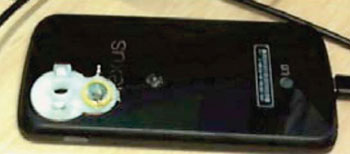Droplet Lens Turns Smart Phones Into Microscopes
By LabMedica International staff writers
Posted on 15 May 2014
A simple and cheap way of making a high-powered lens that can transform a smart phone into a high-resolution microscope has been invented. Posted on 15 May 2014
The lenses are made by using the natural shape of liquid droplets and costing less than a USD 0.01 the lenses promise a revolution in science and medicine in developing countries and remote areas.

Images: The smartphone microscope with polydimethylsiloxane lens (Photo courtesy of the Garvan Institute of Medical Research).
Bioengineers at Garvan Institute of Medical Research (Darlinghurst, NSW, Australia) and their colleagues at other institutes fabricated flexible moldless lens based on curing a hanging transparent polydimethylsiloxane (PDMS) elastomer droplet on a curved substrate. Additional deposition of hanging droplets in the same manner led to a substantial increase in the lens curvature and concomitant decrease in the focal length of the PDMS lenses down to ~2 mm.
The shortest focal length lenses were shown to collimate light from a bare light emitting diode (LED) and image microscopic structures down to around 4 µm with 160 × magnification. The polydimethylsiloxane polymer is the same as that used for contact lenses, and it will not break or scratch. The team designed a lightweight three dimensional (3D)-printable frame to hold the lens, along with a couple of miniature LED lights for illumination, and a coin battery. The technology taps into the current citizen science revolution, which is rapidly transforming owners of smart phones into potential scientists and there are also exciting possibilities for remote medical diagnosis. The addition of a single PDMS lens to a smartphone camera transformed it into a high performance mobile digital microscope platform.
The authors concluded that the fabricated PDMS lenses were shown to greatly increase both the imaging resolution of a miniature camera system, up to 160× magnification, and maintain a fairly constant LED illuminating field. The entire microscope with magnifying power of ~60×, takes up a footprint approximately 30 × 15 × 5 mm, which is at nearly two times smaller than any current commercial mobile microscope system. The study was published on May 1, 2014, in the journal Biomedical Optics Express.
Related Links:
Garvan Institute of Medical Research













